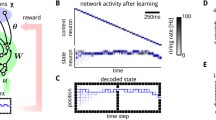Abstract
The knowledge about higher brain centres in insects and how they affect the insect’s behaviour has increased significantly in recent years by experimental investigations. A large body of evidence suggests that higher brain centres of insects are important for learning, short-term and long-term memory and play an important role for context generalisation. In this paper, we focus on artificial recurrent neural networks that model non-linear systems, in particular, Lotka-Volterra systems. After studying the typical behavior and processes that emerge in appropiate Lotka-Volterra systems, we analyze the relationship between sequential memory encoding processes and the higher brain centres in insects in order to propose a way to develop a general ’insect-brain’ control architecture to be implemented on simple robots.
Preview
Unable to display preview. Download preview PDF.
Similar content being viewed by others
References
Afraimovich, V.S., Rabinovich, M.I., Varona, P.: Heteroclinic contours in neural ensembles and the winnerless competition principle. International Journal of Bifurcation and Chaos 14, 1195–1208 (2004)
Freeman, W.J., Yao, Y.: Model of biological pattern recognition with spatially chaotic dynamics. Neural Netw. 3, 153–170 (1990)
Gerber, B., Tanimoto, H., Heisenberg, M.: An engram found? Evaluating the evidence from fruities. Current Opinion in Neurobiology 14, 737–768 (2004)
Hertz, J., Krogh, A., Palmer, R.: Introduction to the Theory of Neural Computation. Addison-Wesley, Santa Fe (1991)
Hölldobler, S., Pan, J.: Knowledge Technologies, Hybrid Approaches and Neural Networks. In: 16th International Conference on Artificial Neural Networks, ICANN06, Athens, Greece (September 2006)
Hopfield, J.: Neural networks and physical systems with emergent collective computational abilities. Proceedings of the National Academy of Sciences of the USA 79, 2554–2558 (1982)
Hornik, K., Stinchcombe, M., White, H.: Universal approximation of an unknown mapping and its derivates using multilayer feedforward networks. Neural Networks 3, 551–560 (1990)
Kelso, J.: Dynamic patterns: the self-organisation of brain and behaviour. MIT Press, Cambridge (1995)
Laurent, G., MacLeod, K., Stopfer, M., Wehr, M.: Spatiotemporal structure of olfactory inputs to the mushroom bodies. Learning and Memory 5, 124–132 (1998)
Laurent, G., Stopfer, M., Freidrich, R.W., Rabinovich, M., Volkovskii, A., Abarbanel, H.D.I.: Annu. Rev. Neurosci. 24, 263 (2001)
McGuire, S.: The role of Drosophila mushroom body signaling in olfactory memory. Science 293, 1330–1333 (2001)
Nepomnyashchikh, V., Podgornyj, K.: Emergence of Adaptive Searching Rules from the Dynamics of a Simple Nonlinear System. Adaptive Behavior 11(4), 245–265 (2003)
Rabinovich, M.I., Varona, P., Abarbanel, H.D.I.: Nonlinear cooperative dynamics of living neurons. Int. J. Bifurcation Chaos 10(5), 913–933 (2000)
Rabinovich, M., Volkovskii, A., Lecanda, P., Huerta, R., Abarbanel, H., Laurent, G.: Dynamical encoding by networks of competing neuron groups: winnerless competition. Physical Review Letters, 87, 068102(4) (2001)
Rabinovich, M.I., Huerta, R., Afraimovich, VI.: Dynamics of Sequential Decision Making. Phys. Rev Lett. 97, 188103 (2006)
Author information
Authors and Affiliations
Editor information
Rights and permissions
Copyright information
© 2007 Springer-Verlag Berlin Heidelberg
About this paper
Cite this paper
Bedia, M.G., Corchado, J.M., Castillo, L.F. (2007). Bio-inspired Memory Generation by Recurrent Neural Networks. In: Sandoval, F., Prieto, A., Cabestany, J., Graña, M. (eds) Computational and Ambient Intelligence. IWANN 2007. Lecture Notes in Computer Science, vol 4507. Springer, Berlin, Heidelberg. https://doi.org/10.1007/978-3-540-73007-1_8
Download citation
DOI: https://doi.org/10.1007/978-3-540-73007-1_8
Publisher Name: Springer, Berlin, Heidelberg
Print ISBN: 978-3-540-73006-4
Online ISBN: 978-3-540-73007-1
eBook Packages: Computer ScienceComputer Science (R0)




